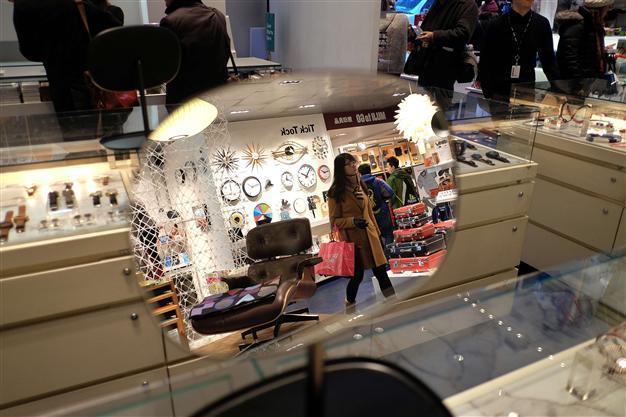New York's MoMA store: a pioneer in innovation
NEW YORK - Agence France-Presse

This photo taken February 5, 2015 show shoppers browsing through one of the Museum of Modern Art (MoMA) stores in New York. AFP Photo
While some museums are still somewhat skittish about selling souvenirs, New York's celebrated MoMA leads the way in retail innovation, its design boutiques almost as popular as the artwork on display.
The museum opened its first shop in 1939 -- a simple sales counter on the MoMA premises on 53rd Street in Manhattan.
More than 70 years later, it has five retail spaces in New York, two of them devoted to design, a store in Tokyo and online shopping sites, two of which cater to the Japanese and Korean markets.
The most well-known of the shops is the store on 53rd Street just opposite the museum. With its serene, artful displays and documented collection, it is almost an extension of the gallery.
Products are presented with a short description, the name of their designer or artist, and the year they were created.
"It's really important to our customers to have the experience they have basically in the museum," Chay Costello, assistant director of merchandising, told AFP.
"We try to reflect that in the stores, and we have signs that tell people who designs this, what the inspiration is, and we carry a number of things that are in our collection," she added.
Some are copies of actual pieces from the MoMA collection, such as the lounge chair and ottoman created by Charles Eames in 1956, which costs more than $4,000.
Others are products exclusive to MoMA that have been sourced by buyers who travel all over the world to replenish the store's twice-yearly collections.
Still more are MoMA innovations, which have only seen the light of day thanks to online crowd-funding sites -- like the "3Doodler," the first 3D printing pen and one of the current best-sellers.
The gadget was born out of a collaboration between MoMA and online fundraising site Kickstarter, and was brought to life by more than 26,500 backers.
In the MoMA shop, even colanders and umbrellas look like art.
On one wall, a video explains the creative process of artist Marina Abramovic, whose plates are sold in the store.
Elsewhere, lamps that create a 3D illusion and were designed by Tel Aviv-based artist Nir Chehanowski are on display.
All products undergo a rigorous selection process.
Those discovered at trade fairs or made by local artisans halfway around the world are brought back to New York and submitted to quality checks and control, she said.
If they pass, they then have to be approved by museum curators.
"That is a really important step along the way to make sure that we maintain the standards of the museum," Costello said.
Innovation, creativity and quality are the watchwords.
"We seek out the most innovative, exciting new products," Costello explained. "We also are looking at bringing products that are representing the future of what good design is going to be." Among items in the shop are bamboo knives, exclusive to MoMA that retail at $10-12, and a glass pan designed by Massimo Castagna for $200.
Among the new items are an adult scooter invented by an Amish family in Pennsylvania for $320, and cardboard suitcases that have been made by the same factory in the Czech Republic since 1925.
MoMA also recently partnered with Japanese apparel chain Uniqlo to make an assortment of clothes that feature art by renowned artists in its collection such as Jean-Michel Basquiat and Jackson Pollock.
The shop on 53rd Street, which opened in 1989, has been so successful that it opened sister branches in 2001 in Manhattan's SoHo district, and in Tokyo in November 2007.
Overall, MoMA shops in New York -- including those inside the museum that sell books, souvenirs and design products -- received 2.5 million visitors last year.
That's nearly as many as the three million who visited the museum and the shops are now indispensable to MoMA's finances.
All profits go to funding educational programs run by the museum or enriching its collections.
"We take it very seriously. We work very hard to make sure the contribution that we are making is dependable," Costello said.
"If they are looking to launch new exhibitions, if they want to acquire new artwork, they know that through the shops we are able to participate to do that," she said.
